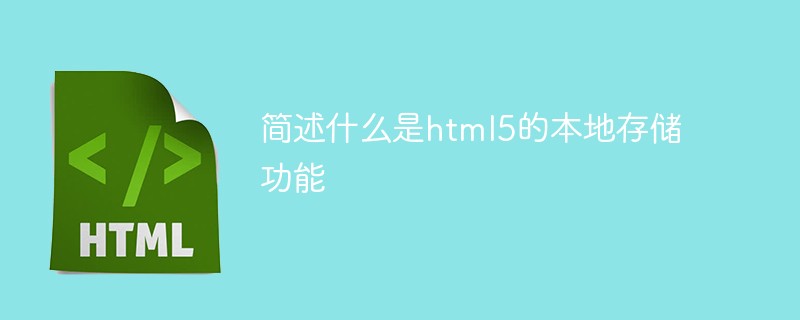What is the local storage function of html5
In HTML5, local storage is a method that allows web pages to store key-value pairs in the user's browser client. Through local storage, web applications can store data locally in the user's browser.

The operating environment of this tutorial: Windows 7 system, HTML5 version, Dell G3 computer.
What is HTML local storage?
Local Storage (LocalStorage) is a method that allows web pages to store key-value pairs on the user's browser client; through local storage, web applications can Store data locally in the user's browser.
htmlLocal storage: Better than cookies
Prior to HTML5, application data could only be stored in cookies, including on every server request. Local storage is more secure and can store large amounts of data locally without affecting website performance.
Unlike cookies, the storage limit is much larger (at least 5MB) and the information is not transferred to the server.
Local storage via origin (via domain and protocol). All pages, from origin, are able to store and access the same data.
About the local storage object of html5:
window.localStorage Store permanent data
window.sessionStorage Store data for a session (when the browser is closed, the stored data will be cleared)
Simulate Taobao search and store local data?
<!DOCTYPE html>
<html>
<head>
<meta charset="UTF-8">
<title>Title</title>
<style>
* {
margin: 0;
padding: 0;
}
#all {
width: 600px;
margin: 100px auto 0px;
position: relative;
}
#all input {
float: left;
width: 500px;
height: 30px;
outline: none;
text-indent: 5px;
border-radius: 15px 0px 0px 15px;
border: 1px solid #ccc;
}
#all button {
float: left;
width: 80px;
height: 32px;
border: none;
color: #fff;
outline: none;
border-radius: 0px 16px 16px 0px;
background-color: orange;
}
#show {
width: 490px;
position: absolute;
left: 10px;
top: 30px;
border: 1px solid #ccc;
border-top: none;
display: none;
}
#show p {
padding-left: 10px;
line-height: 20px;
color: orange;
font-size: 13px;
padding-right: 10px;
}
#show p a {
text-decoration: none;
float: right;
}
</style>
</head>
<body>
<div id="all">
<input type="text" id="text">
<button id="enter">淘宝搜索</button>
<div id="show">
</div>
</div>
<script src="js/jquery-1.8.3.min.js"></script>
<script>
var text = $("#text");
var enter = $("#enter");
var show = $("#show");
var data = localStorage.getItem("historyData") || "[]";
var dataArr = JSON.parse(data);
var init = function () {
if (dataArr.length == 0){
show.hide();
return;
}
show.html("");
$(dataArr).each(function (index, item) {
$("<p></p>").text(item).prependTo(show).append($("<a href='javascript:;'></a>").text("删除").attr("index", index));
});
}
text.focus(function () {
init();
if(dataArr!=0)show.show();
});
enter.click(function () {
var val = text.val().trim();
if (val.length == 0) return;
dataArr.push(val);
localStorage.setItem("historyData", JSON.stringify(dataArr));
text.val("");
init();
});
$("#show").on("click", "a", function () {
var index = $(this).attr("index");
dataArr.splice(index, 1);
localStorage.setItem("historyData", JSON.stringify(dataArr));
init();
});
</script>
</body>
</html> Final rendering:

Related recommendations: "html video tutorial"
The above is the detailed content of What is the local storage function of html5. For more information, please follow other related articles on the PHP Chinese website!

Hot AI Tools

Undresser.AI Undress
AI-powered app for creating realistic nude photos

AI Clothes Remover
Online AI tool for removing clothes from photos.

Undress AI Tool
Undress images for free

Clothoff.io
AI clothes remover

Video Face Swap
Swap faces in any video effortlessly with our completely free AI face swap tool!

Hot Article

Hot Tools

Notepad++7.3.1
Easy-to-use and free code editor

SublimeText3 Chinese version
Chinese version, very easy to use

Zend Studio 13.0.1
Powerful PHP integrated development environment

Dreamweaver CS6
Visual web development tools

SublimeText3 Mac version
God-level code editing software (SublimeText3)

Hot Topics
 1386
1386
 52
52
 Table Border in HTML
Sep 04, 2024 pm 04:49 PM
Table Border in HTML
Sep 04, 2024 pm 04:49 PM
Guide to Table Border in HTML. Here we discuss multiple ways for defining table-border with examples of the Table Border in HTML.
 HTML margin-left
Sep 04, 2024 pm 04:48 PM
HTML margin-left
Sep 04, 2024 pm 04:48 PM
Guide to HTML margin-left. Here we discuss a brief overview on HTML margin-left and its Examples along with its Code Implementation.
 Nested Table in HTML
Sep 04, 2024 pm 04:49 PM
Nested Table in HTML
Sep 04, 2024 pm 04:49 PM
This is a guide to Nested Table in HTML. Here we discuss how to create a table within the table along with the respective examples.
 HTML Table Layout
Sep 04, 2024 pm 04:54 PM
HTML Table Layout
Sep 04, 2024 pm 04:54 PM
Guide to HTML Table Layout. Here we discuss the Values of HTML Table Layout along with the examples and outputs n detail.
 HTML Input Placeholder
Sep 04, 2024 pm 04:54 PM
HTML Input Placeholder
Sep 04, 2024 pm 04:54 PM
Guide to HTML Input Placeholder. Here we discuss the Examples of HTML Input Placeholder along with the codes and outputs.
 Moving Text in HTML
Sep 04, 2024 pm 04:45 PM
Moving Text in HTML
Sep 04, 2024 pm 04:45 PM
Guide to Moving Text in HTML. Here we discuss an introduction, how marquee tag work with syntax and examples to implement.
 HTML Ordered List
Sep 04, 2024 pm 04:43 PM
HTML Ordered List
Sep 04, 2024 pm 04:43 PM
Guide to the HTML Ordered List. Here we also discuss introduction of HTML Ordered list and types along with their example respectively
 HTML onclick Button
Sep 04, 2024 pm 04:49 PM
HTML onclick Button
Sep 04, 2024 pm 04:49 PM
Guide to HTML onclick Button. Here we discuss their introduction, working, examples and onclick Event in various events respectively.




